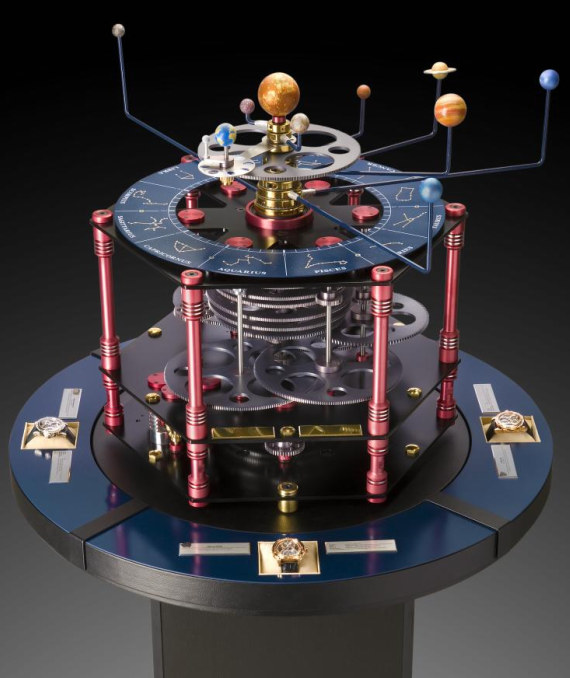
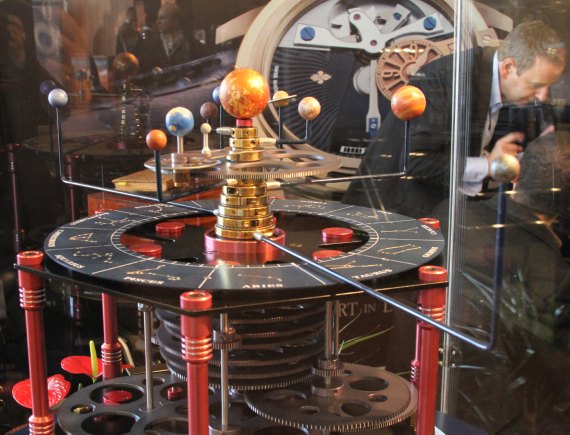
You are looking at the one-of-a-kind Meteoris from watch maker Louis Moinet. Meteoris is a set of four watches and this artfully-made mechanical planetarium. The set is for the serious astrological and horological connoisseur. Clearly very expensive, the set has some interesting features that are worth knowing about. Looking at the planetarium it is clear that the table-like structure is on a pedestal with an ornate mechanical planetarium on it surrounded by four pillow sections for the watches. Actually, given the complexity of the planetarium, I wish that Louis Moinet would have put more effort into giving the watches more appropriate housings. You have four piece unique watches that are each beautifully made tourbillons that are just sitting there on a pillow. At least give them a dust cover.
The planetarium weighs about 100 kilos and is 150mm tall, and about 91cm in diameter. The table and mechanics where done by the mechanic Rémy Chauvin. Like all good stubborn watch makers, Louis Moinet refuses to let go of Pluto as a planet in the solar system, so it is right there along with the rest of the planets as well as the Sun. The contraption features the Sun in the center with each of the planets moving around it in real time. The planets and Sun where made by artist Jean-Yves Kervévan. Each of the paints and varnishes used are hand made, and dust from meteorites is used on some of the orbs . Only the Earth has its moon represented which revolves around the Earth. There is a scale for the zodiac that show was period we are in. Each of the constellations of the zodiac is covered in gold dust and top Wesselton VVS diamonds (154 of them totaling 5.6 carats). The planetarium mechanics are a bit of a mystery to me right now. I know they are all well made, but I am not sure if the device is electrically powered, or somehow manually wound. It is a pretty neat item to have in one’s study or foyer, but I would dare not place the Meteoris with the watches in a place where people can snag one of them easily. The Meteoris also has a foot switch that can be activate to show you the rotation of the plants sped up, as simply watches them move in real time would be very slow.
While the planetarium part of the Meteoris is relatively impressive, the watches are more my thing. Maybe I would be more into the planetarium if it didn’t look like places for the watches were an afterthought. The set comes with four piece unique watches that are each slight different versions of the Louis Moinet Vertalis Tourbillon watch. The case and overall design is carried over, but each watch here is a bit different. The pudding is all in the dials. Be it in 18k white gold or rose gold, the watches all come down to their astrological dials.
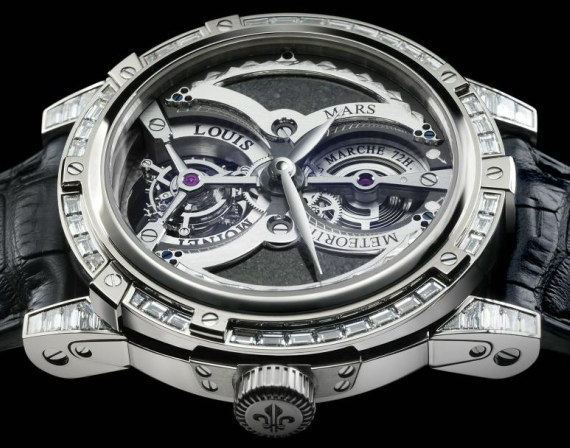
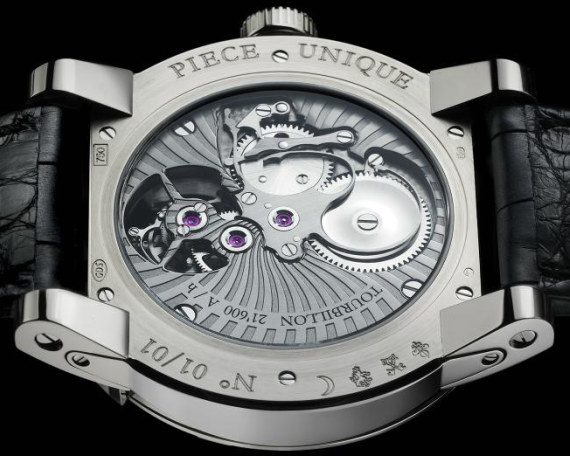
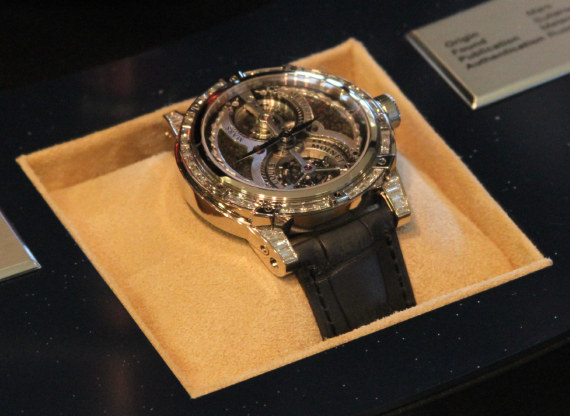
Starting with the top down, the first watch is the Louis Moinet Meteoris Tourbillon Mars watch. Each of the Meteoris watches are 47mm wide with complex cases that are made of about 50 parts. The watches have sapphire crystal and one-minute tourbillon manually wound movements. The movements also have a partially skeletonized main spring barrel that shows the tautness of the main spring as a form of power reserve indicator (total of about 72 hours). The Mars watch further has 3.46 carats of 56 baguette cut diamonds on the case bezel and lugs. The dial around the openings is made from a meteorite called “Jiddat al Haraiss 479” that was found in Oman and authenticated as originating from Mars by the Russian Academy of Sciences in Moscow.
Next on the solar system list here is the Louis Moinet Meteoris Rosetta Stone watch. What does this mean? Well the rose gold watch has a dial that is made from the oldest meteorite found on Earth. It is the Sahara 99555 stone, and nicknamed the “Rosetta Stone” (no relation to the language tablets also known as the Rosetta Stone) and is said to be 4.5662 billion years old. According to the Institute for Planetology of Munster, Germany, this stone is thought to have originated from the planet Mercury.
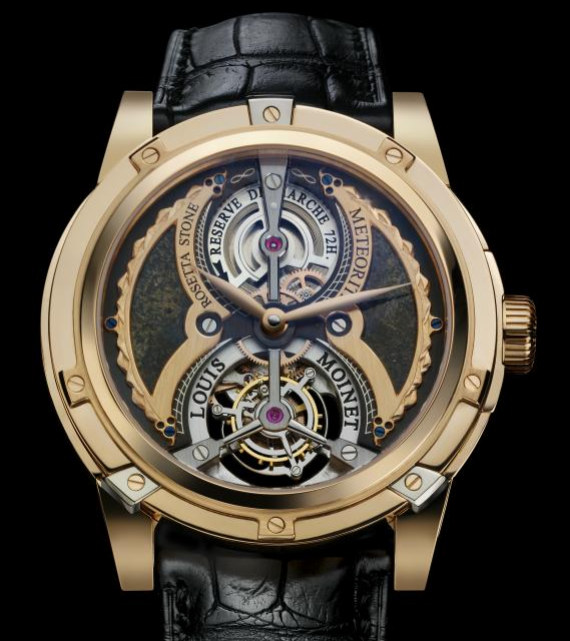
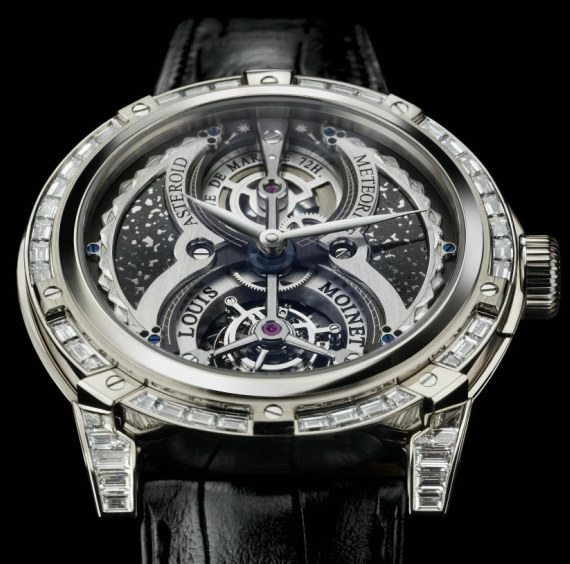
Third is the Louis Moinet Meteoris Tourbillon Asteroid watch. You guess it, 18k white gold case, more diamonds and the dial here is from a meteorite that came off of an asteroid. The stone was found in the western Sahara desert in Africa. You’ll notice that each of the watches has a small, but unique engraving mirrored and on the top of the watch at the apex of the mainspring barrel. Here the image shows a little meteorite said to be falling to Earth. The stone is quite lovely as the dial and is cut from Itqiy (the name of the meteorite). It was said to be formed near the Sun, and was authenticated by (my alma mater) the University of Arizona in Tucson.
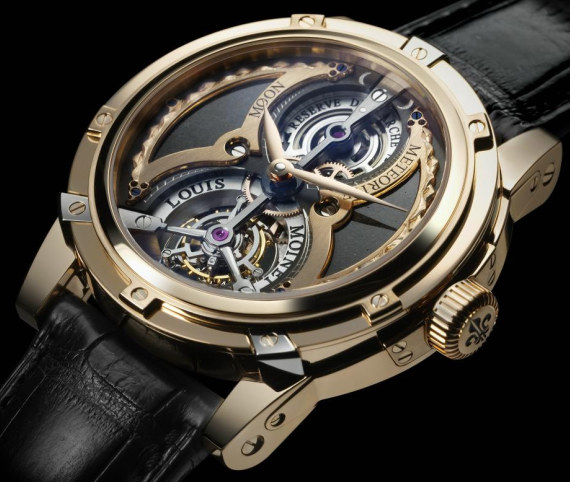
Fourth and final for the Meteoris watches is the Louis Moinet Meteoris Tourbillon Moon watch. Again you have the lovely and large Jules Verne style watch case as taken from the style of original Louis Moinet drawings attached to the alligator strap with a dial that is bona bide moon rock. Once again from Oman, the stone is from a meteorite called Dhofar 459, and has been authenticated by UCLA. Once again, each of the dials used for these watches was cut from stones found terrestrially on Earth and are considered very rare. For serious (and seriously wealthy) watch lovers, the Louis Moinet Meteoris is the ultimate collection and there will only be one set. Price is an easy to swallow $4.9 million. Available now !
[phpbay]louis moinet | meteorite, num, “14324”, “”[/phpbay]
